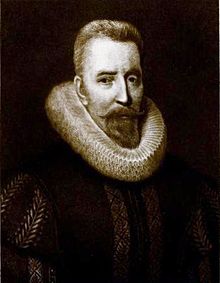Thomas Hamilton, 1st Earl of Haddington
This article uses bare URLs, which may be threatened by link rot. (May 2021) |

Thomas Hamilton, 1st Earl of Haddington (1563 – 29 May 1637), designated before his peerage as 'of Drumcarny, Monkland, and Binning', was a Scottish administrator, Lord Advocate, judge, and Lord Lieutenant of Haddingtonshire.
Family[]
The son of Sir Thomas Hamilton of Priestield, a judge of the Court of Session as Lord Prestonfield, by his first wife Elizabeth, daughter of James Heriot of Trabroun, Haddingtonshire. His younger brother was Andrew Hamilton, Lord Redhouse.
Thomas was educated in Paris. He became known as Thomas Hamilton of Drumcarny.
Legal career[]
He was admitted an Advocate in 1587, a Lord of Session in 1592, appointed Lord Advocate in 1596, Lord Clerk Register in 1612, and in 1616 became Lord President of the Court of Session.
On 22 November 1596 James VI ordered him to try Jonet Garvie at an assize for witchcraft.[1]
Administrator[]
He was on very friendly terms with James VI, his legal talents being useful to the king. In July 1593 he was appointed to a council to manage the estates and finances of Anne of Denmark.[2] He was one of the eight men called the Octavians who were appointed to manage the finances of Scotland. Widely regarded as an able administrator, Hamilton was entrusted with a large share in the government of Scotland when James removed to London in 1603.
He was present at Stirling Castle on 10 May 1603 when Anne of Denmark argued with Marie Stewart, Countess of Mar and the Master of Mar to gain custody of her son Prince Henry.[3] He wrote an account of the incident.[4]
In 1612 he was appointed Lord Clerk Register to the Privy Council to succeed John Skene. After the death of James VI the earl resigned his offices, but served Charles I as Keeper of the Privy Seal of Scotland. Thomas was referred familiarly to his friends as 'Tam o' the Cowgate', his Edinburgh residence being in that street.
Peerages[]
On 19 November 1613, he was created a Lord of Parliament as Lord Binning. Further, on 20 March 1619, he was created Earl of Melrose. Upon the death of the first and last Viscount of Haddington (on 28 February 1626), the king agreed to exchange the title of Earl of Melrose to that of Earl of Haddington, with the original precedence and remainder to heirs male bearing the surname and Arms of Hamilton. In 1628 The Earl of Haddington purchased the Tyninghame estate for 200,000 merks.
In 1624, under the title of Thomas Hamilton, Earl of Melrose, he purchased south-east of North Berwick.[5]
Marriages[]
The 1st Earl of Haddington married, (1) c. 1588, Margaret (d. Dec 1596), only child of James Borthwick of Newbyres, by whom he had two daughters. He remarried (2) in 1597, Margaret Foulis (d. 31 May 1609), daughter of James Foulis of Colinton, and sister of the financier Thomas Foulis. Their children include:
- Thomas Hamilton, 2nd Earl of Haddington, a Covenanter, killed at Dunglass Castle in an explosion on 30 August 1640. Married Catherine Erskine daughter of Marie Stewart, Countess of Mar, with issue.
- Sir John Hamilton of Trabroun (dvp). Married with issue who died young.
- Lady Jean Hamilton, who married John Kennedy, 6th Earl of Cassilis, and had issue, including Lady Margaret Burnet, who married c.1672 Gilbert Burnet, later Bishop of Salisbury.
The 1st Earl married again (3) on 3 September 1613, Julian (buried 30 March 1637), daughter of Sir Thomas Ker of Ferniehirst, and widow of Sir Patrick Hume of Polwarth, by whom he had another son:
- Robert Hamilton, born 14 May 1614 and killed in the explosion at Dunglass Castle on 30 August 1640, unmarried.
References[]
- ^ William Fraser, Memoirs of the Earls of Haddington, vol. 2 (Edinburgh, 1889), p. 69.
- ^ Annie I. Cameron, Calendar of State Papers: 1593-1595, vol. 11 (Edinburgh, 1936), p. 696.
- ^ James Maidment, Letters and State Papers during the Reign of James the Sixth (Edinburgh, 1838), p. 54.
- ^ William Fraser, Memorials of the Earls of Haddington, vol. 2 (Edinburgh, 1889), pp. 209–11
- ^ http://www.stravaiging.com/history/castle/balgone-house
- Brown, Peter, publisher, The Peerage of Scotland, Edinburgh, 1834, p. 105.
- Mosley, Charles, editor, Burke's Peerage & Baronetage, 106th edition, 1999, vol.1, p. 1262, ISBN 2-940085-02-1
- 1563 births
- 1637 deaths
- Members of the Faculty of Advocates
- Earls of Haddington
- Senators of the College of Justice
- Lord Advocates
- Lords President of the Court of Session
- Members of the Privy Council of Scotland
- 16th-century Scottish people
- 17th-century Scottish peers
- Peers of Scotland created by James VI
- Members of the Convention of the Estates of Scotland 1621
- Members of the Convention of the Estates of Scotland 1630
- Lord-Lieutenants of East Lothian
- Octavians